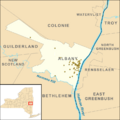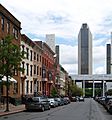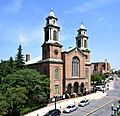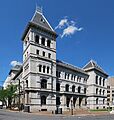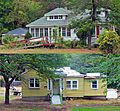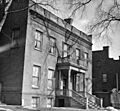National Register of Historic Places listings in Albany, New York facts for kids
There are 75 special places in Albany, New York, listed on the National Register of Historic Places. Six of these are even more important, called National Historic Landmarks (NHLs). That's more than any other city in New York State, except for New York City.
These listed places show us about 250 years of Albany's story. This includes its beginnings with the Dutch and its growth into the mid-1900s. Since Albany is New York's state capital, many important government buildings are on the list. This includes the main buildings for all three parts of the state government. Also listed are City Hall, the main offices for the city's schools, and the big churches (cathedrals) for both the Episcopal and Roman Catholic faiths.
Some of these places are unique! For example, there's a possible grave of the only British noble buried in the U.S. There's also the only destroyer escort ship still floating and a very rare type of fireplace. Other places are famous for "firsts," like where electrical inductance was discovered. The State Department of Education building was the first state building in the country just for education. And the first basketball game played outside of Massachusetts (where it was invented) happened here!
Famous architects like Henry Hobson Richardson and Stanford White designed some of these buildings. Many important people are connected to these places, including George Washington and John McCloskey.
Contents
What is the National Register of Historic Places?
The National Register of Historic Places is the official list of important historic places in the U.S. It was started in 1966 by the National Historic Preservation Act of 1966. The National Park Service (NPS) manages this list.
To get on the National Register, a place usually first needs to be approved by its state's historic preservation office. Then, it's nominated to the national list. In New York, the state's Office of Parks, Recreation and Historic Preservation helps with this.
A separate program by the NPS names National Historic Landmarks (NHLs). These are places that are extra special and important to the whole country. The Secretary of the Interior officially names them. Many NHLs are also on the National Register, but they don't have to be.
Where are Albany's historic places located?
Most of Albany's listed properties are in the central part of the city. This area is close to the Hudson River and was where the city first started. Today, this area is mostly covered by the Downtown Albany Historic District.
The Albany Felt Company Complex is in the city's northeast corner. The Nut Grove is near the city's southern edge. The Rapp Road Community Historic District is in the far west and north.
The downtown historic district follows the old boundaries of a stockade (a fence made of strong posts) that the Dutch built in 1624. This was part of Fort Orange. The hidden remains of this fort are one of Albany's National Historic Landmarks and its oldest listed site. For a long time, downtown was the entire developed city.
What are historic districts?
Historic districts are groups of properties that share a common history. They are often owned by different people but are recognized together because of their shared past. In Albany, there are 14 historic districts on the National Register.
Most of these districts are close together, near the river. They vary in size. For example, the Washington Park district is 136 acres, while smaller ones like "Broadway Row" (officially Buildings at 744–750 Broadway) are less than an acre.
Together, these historic districts cover about 580 acres, which is about 4% of Albany's total land. They include over 2,000 buildings, structures, or sites. More than 90% of these are considered "contributing properties," meaning they add to the district's historic feel.
Most districts are mainly homes, with some other buildings mixed in. They show different times in Albany's growth. Some were once neighborhoods for rich families, like the Ten Broeck Triangle. Others were settled by immigrants, like the Mansion District. The downtown area is mostly for businesses. The Lafayette Park Historic District has mostly government buildings and parks.
Types of Historic Properties
Out of the 43 listed properties that are still standing, most are buildings or groups of buildings. Only three are not buildings: the Whipple Cast and Wrought Iron Bowstring Truss Bridge (a structure), the USS Slater (a ship), and Fort Orange (an archaeological site). Historic districts also include other structures like parks and statues.
Government and Military Buildings
Albany is New York's capital, so many listed buildings are for government use. Seventeen of the 41 standing individual buildings have been used by the government. Three are for the city government, two for the school district, and one for the federal government (Old Post Office). The rest are for the state government.
These state buildings include the governor's mansion, the Court of Appeals Building (for courts), and the state capitol (for laws). Only three other states have all three main government branches in individually listed buildings.
The James T. Foley United States Courthouse is a federal building in the downtown area. It houses the federal court for northern New York. The county courthouse is also a contributing property in the Lafayette Park district.
Four listed properties have been used for military purposes. The original Fort Orange was built by the Dutch to protect their settlement. In the late 1800s, the state built two armories for the National Guard. The Slater ship was used by the Navy in World War II.
Education, Arts, and Sciences
Government groups also own four buildings used for education. Three are for administration: the Old Albany Academy Building (now the school district's main office), the former headquarters of a railroad (now for the State University of New York system), and the State Department of Education Building. The James Hall Office building is now part of an elementary school. The former Philip Livingston Magnet Academy is the only listed public school building built for that purpose.
The Harmanus Bleecker Library was the city's first library. It's now private office space. Two other buildings, the Albany Institute of History & Art and the Palace Theatre, were built for their current cultural roles. The Institute is a major museum. Three historic house museums and the Slater ship are also museums. The Washington Avenue Armory is now used for concerts.
Three properties celebrate scientific discoveries. At the Albany Academy, Joseph Henry discovered electrical inductance. This led to the telegraph and other technologies. The building is now named after him. James Hall made many paleontology and geology discoveries in his office and lab.
Squire Whipple was an Albany resident who studied how bridges work. The Whipple Cast and Wrought Iron Bowstring Truss Bridge is named after his design. It's one of the oldest iron bridges in the country and one of the few that uses both cast and wrought iron.
Churches and Other Organizations
All 10 listed buildings used for religious purposes are Christian churches. Two are Catholic, and six are Protestant. The Church of the Holy Innocents is empty now.
Three churches are home to Albany's oldest congregations: the First Reformed Church, St. Peter's Episcopal Church, and St. Mary's Church. The First Reformed Church, from 1634, is the oldest Christian church building in upstate New York. St. Mary's is the oldest Catholic church in the city. The Cathedral of All Saints and the Cathedral of the Immaculate Conception are the main churches (cathedrals) for the Episcopal and Catholic areas of Albany. The Immaculate Conception is the second-oldest Catholic cathedral in New York State.
Fourteen churches are contributing properties in the historic districts. This includes St. Joseph's, Albany's third Catholic church.
Only one property is used by a non-religious non-profit organization. Nut Grove, an old mansion, is now part of a rehabilitation center. The Schuyler Mansion was once a large estate and later an orphanage.
Homes and Businesses
Nine listed properties are or were single-family homes. Only the governor's mansion is still used as a home. Four others have been changed into offices or businesses. Three old mansions—Cherry Hill, the Schuyler, and Ten Broeck—are now historic house museums. The Stephen and Harriet Myers Residence, a former stop on the Underground Railroad, is being turned into a museum.
Most historic districts are full of homes. The smallest ones, like Jermain Street and Rapp Road, have only houses. The Broadway Row has four rowhouses. Only the downtown area is mainly for businesses.
Eleven listed buildings were built or changed for commercial use. Most are still used for business. The former headquarters of the Delaware and Hudson Railroad is now a government and education building. The city's Quackenbush Pumping Station is now the Albany Pump Station brewpub.
The downtown historic district includes many important business buildings. This includes the Home Savings Bank Building, which was Albany's tallest building when it was built in 1927. Lark Street and South Pearl Street are also important business areas.
Transportation and City Services
Two listed properties were used for transportation: the former Union Station building and the Whipple Cast and Wrought Iron Bowstring Truss Bridge. The station is now offices. The bridge, once for cars, is now only for people walking.
The Albany Pump Station was once the Quackenbush Pumping Station, part of the city's water system. It pumped water from the Hudson River. After 1937, it was no longer needed for water and is now a brewpub.
The Broadway–Livingston Avenue Historic District includes an old railroad bridge from 1900. In the Center Square area, there's one of two remaining poles from the city's old trolley system.
Parks and Green Spaces
Four parks in Albany are on the list. Lincoln Park is listed on its own. Swinburne Park is listed with the nearby Bleecker Stadium. Lafayette and Washington parks are part of their historic districts.
Albany's Architecture and Styles
Most of Albany's listed properties were built between the mid-1800s and early 1900s. This was a time when the city was growing and becoming very successful. So, the architectural styles from that era are very common.
Even though the Dutch founded Albany, only one listed building, the Van Ostrande–Radliff House, is a true example of Dutch Colonial architecture. It's the city's oldest building. It even has the only "jambless fireplace" (a fireplace without side supports) of its kind left in the U.S. English colonial styles are seen in the Georgian Schuyler Mansion.
The Ten Broeck Mansion, built in the late 1700s, shows the change from colonial styles to the new Federal style after American independence. Philip Hooker designed the First Reformed Church and the Old Albany Academy Building, which are also Federal style.
After the Erie Canal opened in the 1820s, the Greek Revival style became popular. The Broadway Row shows this change. This style was used for fancy homes and also for simpler houses. The Court of Appeals Building is a grand example of Greek Revival. Alexander Jackson Davis designed Nut Grove, a rare Greek Revival country house.
Later in the 1800s, Victorian styles appeared. The James Hall Office building, built in 1852, is an example of the Italianate style. Many rowhouses were built in this style. The Walter Merchant House is a rare, large Italianate house that still stands.
Churches helped bring the Gothic Revival style to Albany. The Church of the Holy Innocents (1850) and the Cathedral of the Immaculate Conception (1852) are early examples. Richard Upjohn and his son designed the St. Peter's Episcopal Church in the French Gothic style.
The state capitol building shows several architectural changes. It started in the Second Empire style, then changed to Renaissance Revival, and finally to a more Romanesque style.
Some architects who worked on the capitol also designed other Albany buildings. Henry Hobson Richardson designed City Hall after a fire. Isaac Perry built the Washington Avenue Armory. The 1883 post office also used the Renaissance Revival style.
Towards the end of the 1800s, more decorative styles appeared. Richard Morris Hunt built the Rice Mansion, a Beaux Arts mansion that is now part of the Albany Institute of History & Art. The new Union Station (1899–1900) also used the Beaux-Arts style.
In the early 1900s, the Colonial Revival style came to Albany. Stanford White designed the Benjamin Walworth Arnold House in 1905, which was the first to use this style. The First Congregational Church of Albany (1917) was the city's first Colonial Revival church. The Philip Livingston Magnet Academy (1930s) is another important Colonial Revival building.
How Albany Grew Over Time
Albany grew a lot after the Erie Canal was finished in 1825. Many immigrants came to the city. The city expanded north and south, taking over large estates like the Schuyler Mansion and Cherry Hill. This led to the creation of historic districts like Arbor Hill and the Mansion District.
West of the old city center, the first city hall and state capitol buildings near what is now Lafayette Park encouraged growth in the early 1800s. Later, the completion of the current capitol and Washington Park helped the city grow even more to the west, creating the Center Square neighborhood.
By the 1920s, streetcar lines reached newer, more suburban areas to the west. Two listed churches helped develop the Pine Hills neighborhood. The city built Hook and Ladder No. 4, a fire station, for another new area. After World War II, new homes and technologies led to the Lustron Houses of Jermain Street Historic District, which are the most recently built listed properties in the city.
Images for kids
See also


